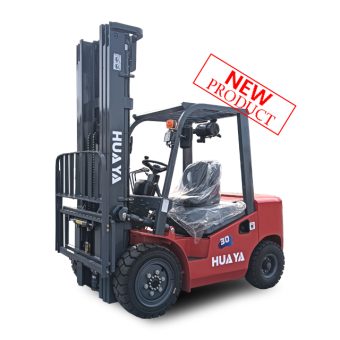
Nachrichten
Ausrüstung für den Materialtransport ist für den effizienten Transport, die Lagerung und die Verwaltung von Materialien in verschiedenen Branchen unerlässlich. Ein Verständnis der vier Hauptgruppen von Materialtransportgeräten kann Unternehmen helfen, ihre Abläufe zu optimieren, Kosten zu senken und die Sicherheit zu verbessern.

Transportmittel wird eingesetzt, um Materialien innerhalb einer Einrichtung oder zwischen verschiedenen Standorten von einem Ort zum anderen zu transportieren. Gabelstapler gehören zu den vielseitigsten und am weitesten verbreiteten Transportgeräten in verschiedenen Branchen.
Gabelstapler gibt es in verschiedenen Ausführungen, z. B. mit Elektro-, Diesel- und Gasantrieb, die jeweils für unterschiedliche Umgebungen und Anwendungen geeignet sind. Sie sind darauf ausgelegt, schwere Lasten zu transportieren und für Stabilität beim Transport zu sorgen.
Elektro-Gabelstapler: Aufgrund ihres leisen und emissionsfreien Betriebs sind sie ideal für den Einsatz in Innenräumen von Lagerhallen und Produktionsstätten.
Diesel-Gabelstapler: Geeignet für den Außeneinsatz auf Baustellen und in der Schwerindustrie, wo höhere Hubkapazitäten erforderlich sind.
Gasbetriebene Gabelstapler: Vielseitig einsetzbar für den Innen- und Außenbereich, mit einem ausgewogenen Verhältnis zwischen Leistung und Emissionen.
Hohe Stabilität und Tragfähigkeit.
Vielseitiger Einsatz in verschiedenen Branchen.
Bessere Manövrierbarkeit und höherer Bedienkomfort.
Lagereinrichtungen werden verwendet, um Materialien über einen bestimmten Zeitraum zu halten oder zu puffern. Gabelstapler spielen eine entscheidende Rolle bei der effizienten Verwaltung und Organisation von Lagerräumen.
Gabelstapler sind unentbehrlich für den Transport und das Stapeln von Materialien in Lagerregalen, Regalen und Behältern. Durch ihre Fähigkeit, schwere Lasten präzise zu heben und zu platzieren, sind sie von unschätzbarem Wert für die Aufrechterhaltung eines organisierten und zugänglichen Lagersystems.
Palettenregale: Für die Lagerung von palettierten Waren, die oft hoch gestapelt werden, um den vertikalen Raum zu maximieren.
Kragarmregale: Ideal für lange oder sperrige Gegenstände wie Holz und Rohre.
Drive-In-Racks: Erlauben Sie den Gabelstaplern, zum Be- und Entladen direkt in die Regalstruktur zu fahren.
Effiziente Nutzung des vertikalen Raums.
Schnelles und sicheres Be- und Entladen.
Geringeres Risiko einer Beschädigung des gelagerten Materials.
Positioniergeräte werden eingesetzt, um Materialien an einem einzigen Ort zu handhaben und sicherzustellen, dass sie sich in der richtigen Position für die anschließende Handhabung, Bearbeitung, den Transport oder die Lagerung befinden. Gabelstapler eignen sich aufgrund ihrer präzisen Steuerung und ihrer Hebefähigkeiten hervorragend für diese Aufgabe.
Gabelstapler können mit verschiedenen Anbaugeräten ausgestattet werden, um spezifische Positionierungsaufgaben zu bewältigen. Diese Vielseitigkeit ermöglicht es ihnen, Funktionen zu erfüllen, die über einfaches Heben und Transportieren hinausgehen.
Seitenschieber: Lassen Sie den Gabelstapler die Lasten seitlich bewegen, um sie präzise zu platzieren.
Rotatoren: Ermöglichen dem Gabelstapler das Drehen von Lasten, was in Branchen wie Recycling und Abfallwirtschaft nützlich ist.
Zinkenverstellgeräte: Stellen Sie den Abstand zwischen den Gabeln ein, um verschiedene Palettengrößen zu handhaben.
Erhöhte Präzision bei der Materialhandhabung.
Erhöhte Sicherheit und Ergonomie für die Bediener.
Vielseitigkeit durch zahlreiche Befestigungsmöglichkeiten.
Geräte zur Bildung von Ladeeinheiten werden eingesetzt, um Materialien so zu begrenzen, dass sie ihre Integrität behalten, wenn sie während des Transports und der Lagerung als eine einzige Ladung gehandhabt werden. Gabelstapler sind ein wesentlicher Bestandteil dieses Prozesses, insbesondere bei der Handhabung von Paletten und Containern.
Gabelstapler sind für die effiziente Handhabung von Stückgütern ausgelegt, sei es beim Stapeln von Paletten oder beim Transport großer Container. Dank ihrer robusten Konstruktion und ihrer Hubkapazität sind sie ideal für die Bildung und den Transport von Stückgütern.
Palettenhandling: Stapeln und Transportieren von palettierten Waren.
Containerumschlag: Transport von Großcontainern in Schifffahrt und Logistik.
Ladungsumhüllung: Sicherstellen, dass die Ladungen sicher verpackt sind, um die Stabilität während des Transports zu gewährleisten.
Verbesserte Stabilität und Schutz der Waren.
Effiziente Handhabung von großen und schweren Stückgütern.
Höhere Produktivität beim Materialtransport.
Materialhandhabungsausrüstung bezieht sich auf Werkzeuge und Maschinen, die zum Bewegen, Lagern, Kontrollieren und Schützen von Materialien während der Herstellungs-, Vertriebs-, Verbrauchs- und Entsorgungsprozesse verwendet werden.
Gabelstapler zeichnen sich durch hohe Stabilität, Vielseitigkeit und Tragfähigkeit aus und sind daher für den effizienten Materialtransport in verschiedenen Branchen unerlässlich.
Berücksichtigen Sie die Art und das Gewicht der Materialien, die Betriebsumgebung, die Energiequelle (Strom, Diesel oder Gas) und die spezifischen betrieblichen Anforderungen.
Ja, viele Hersteller bieten maßgeschneiderte Lösungen mit verschiedenen Anbaugeräten und Spezifikationen an, um spezifische Branchenanforderungen und betriebliche Herausforderungen zu erfüllen.
Ein Verständnis der vier Hauptgruppen von Materialtransportgeräten - Transportgeräte, Lagergeräte, Positioniergeräte und Geräte zur Bildung von Ladeeinheiten - mit dem Schwerpunkt auf Gabelstaplern kann Ihre betriebliche Effizienz erheblich verbessern. Durch die Auswahl der richtigen Gabelstapler und Anbaugeräte für Ihre Bedürfnisse können Sie Ihre Arbeitsabläufe optimieren, Kosten senken und die Sicherheit in Ihrem Betrieb erhöhen.
Vorherige: Wie lautet die OSHA-Norm für Gabelstapler?



